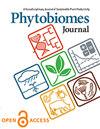Evaluation of different phyllosphere sample types for parallel metabarcoding of Fungi and Oomycetes in Vitis vinifera
IF 3.3
3区 生物学
Q2 MICROBIOLOGY
引用次数: 3
Abstract
Metabarcoding is an effective and cost efficient approach to study environmental microbiomes and has become a standard method in studying microbial community structures and relative species abundance. In grapevine research on leaf microbial communities, two kinds of sample types, either leaf wash sediments representing the phyllosphere microbiome from leaf surfaces, or leaf tissue samples, e.g. leaf disks, including phyllosphere and endosphere microorganisms, are used to characterize leaf microbiomes. The goal of this study was to analyze the advantages and disadvantages of these sample preparation methods for the characterization of the phyllosphere microbiome by fungal metabarcoding with both sample types being processed from the exact same set of leaves. We used a metabarcoding strategy which is capable of detecting Fungi and Oomycetes facilitating the parallel analysis of these communities. At each sampling time point species richness was shown to be higher in leaf wash samples and differences in the community structure between samples was smaller for this sample type, as well. Furthermore, by comparing read count abundance to qPCR measured relative proportions of selected amplicon sequence variants (ASVs), a higher congruence was observed for leaf wash samples. Therefore, metabarcoding analyses of leaf samples using leaf wash sediments outperforms analyses using leaf disks and should be applied to characterize phyllosphere fungal communities. As a second goal we show that the direct comparison of metabarcoding libraries of both sample types prepared from the exact same set of leaves also provides a new strategy to identify potentially not culturable endophytes.葡萄不同层球样品类型对真菌和卵菌平行元条形码的评价
代谢编码是研究环境微生物组的一种有效且成本效益高的方法,已成为研究微生物群落结构和相对物种丰度的标准方法。在葡萄藤对叶片微生物群落的研究中,使用两种样品类型来表征叶片微生物组,即代表叶片表面叶层微生物组的叶洗沉积物,或叶组织样品,如叶盘,包括叶层和内层微生物。本研究的目的是分析这些样品制备方法的优缺点,通过真菌代谢条形码对叶层微生物组进行表征,两种样品类型都是从完全相同的叶片中加工而成。我们使用了一种代谢编码策略,该策略能够检测真菌和卵菌,促进对这些群落的平行分析。在每个采样时间点,洗叶样本的物种丰富度较高,该样本类型样本之间的群落结构差异也较小。此外,通过将读取计数丰度与qPCR测量的所选扩增子序列变体(ASV)的相对比例进行比较,观察到洗叶样品的一致性更高。因此,使用叶洗沉积物对叶片样本进行的代谢条形码分析优于使用叶盘进行的分析,应用于表征叶层真菌群落。作为第二个目标,我们表明,直接比较由完全相同的一组叶子制备的两种样品类型的代谢条形码文库也为鉴定潜在的不可培养的内生菌提供了一种新的策略。
本文章由计算机程序翻译,如有差异,请以英文原文为准。
求助全文
约1分钟内获得全文
求助全文

 求助内容:
求助内容: 应助结果提醒方式:
应助结果提醒方式:


